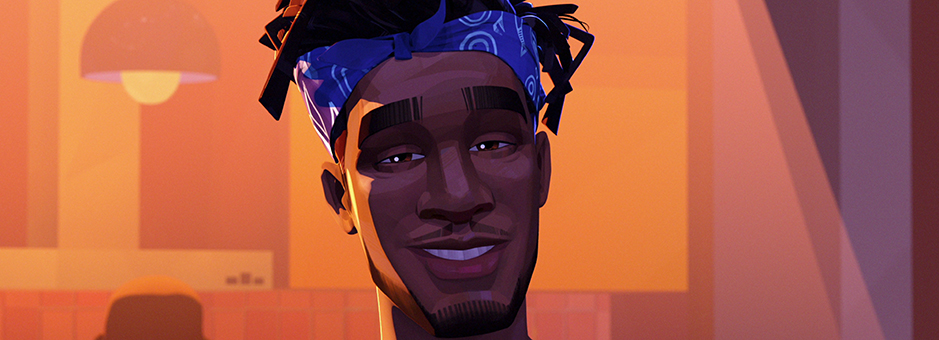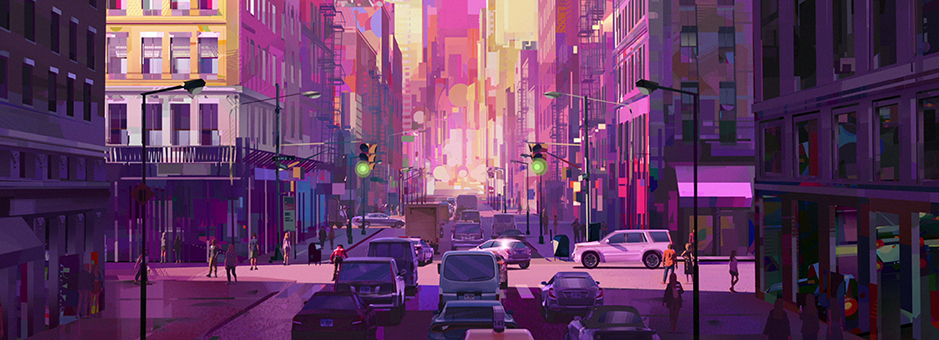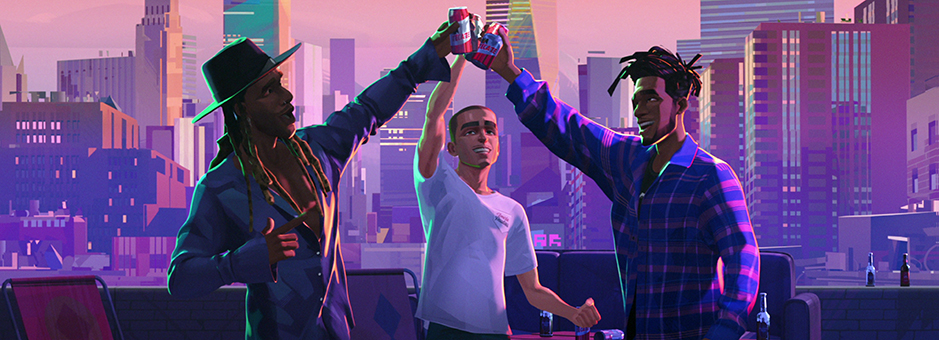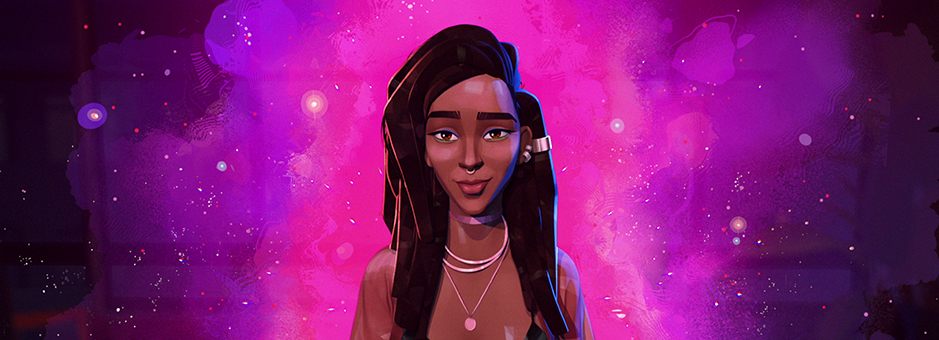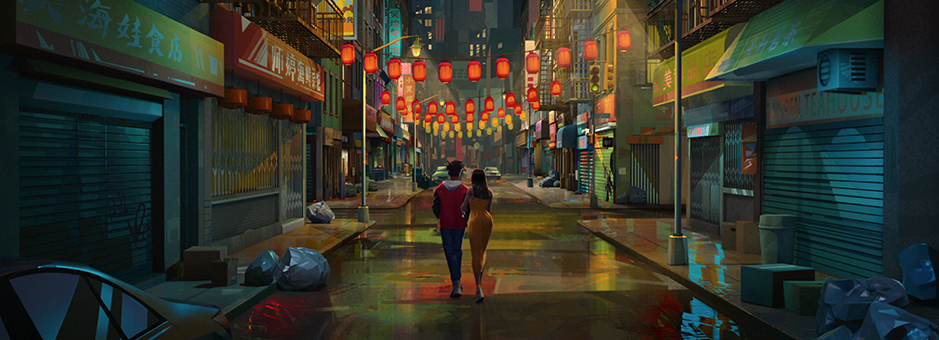Case Studies
Colour in animation – Entergalactic
Picture Shop Senior Colourist Doug Delaney started his career in post-production shortly after moving to Los Angeles in 1995, where he began learning the art and science of film imaging for visual effects. Since then he has built a career collaborating with top film timers, VFX supervisors, and colour scientists and working with some of the industry’s most acclaimed filmmakers on a mixture of renowned live-action and animated projects, including Captain Marvel (2019); The Equalizer (2014); Concussion (2015); Monster: The Jeffrey Dahmer Story (2022); and Love, Death & Robots (Vol 3, 2022).
Most recently, Delaney handled the colour grading on the Netflix animated special, Entergalactic. The film is an adult music television special created by American musician and actor Kid Cudi and directed by Fletcher Moules. It premiered on Netflix in September 2022.
Entergalactic tells the story of Jabari, a charming, streetwear-clad artist on the cusp of real success. After a chance run-in with his cool new photographer neighbour, Meadow, Jabari has to figure out whether he can make space for love in his life.
Honouring the art of animation
Having worked on a variety of both live action and animated projects in his career, Delaney is well aware of the different requirements and expectations when it comes to grading animation.
“For a live action movie, assuming we’re involved early on in camera tests, which more and more we are, we have a more direct role in helping the cinematographer and film makers create the look and feel,” he comments. “You could be involved from the get-go, with dailies, pre-production and camera tests. It’s great creatively to be involved in that and, ideally, get to read the scripts and really understand the show before you step foot in it.”
Animation is a much longer process with some differences in terms of what is being asked of the colourist.
“However, there are many similarities in terms of the objective,” Delaney explains. “For example, in physical production we can be fixing things like weather issues or consistency, time of day or editorial changes. These types of fixes don’t happen in animation, but there are other factors that require us to nuance and refine the scenes. It might come from two different places, but it’s the same end goal.”
Delaney feels that animation in general can be a bit more technical in terms of approach.
“There is more specificity in animation, because they have lived with it and designed it and literally painted and rendered it in a very specific way,” he explains. “The challenge is to serve and honour this, and to tackle the technical challenges of ensuring that it remains consistent, and all parties involved are seeing what they expect to see. And then maintaining this through all the various deliverables and processes.
“Of course, this is also important in live action, but I think in animation it's even more so.”
Enter… Entergalactic
Following his work on Love, Death & Robots, Delaney was approached by the Entergalactic team to help with the grade. For an animation project, he was brought in early in the process and was able to support the team with both creative and technical advice.
“It was the height of COVID, so I was invited to a few Zoom interviews with art director, Robh Ruppel and Fletcher, the director,” says Delaney. “We kicked the tyres about what they were looking for and what I could bring to the table, and we did some early colour tests to sort out the colour pipeline as well as some technical pre-production calls.”
Character mattes
Delaney wanted to be granular with his ability to assist in final grade and suggested they create masters for each of the characters, developing a matte for each one.
“The technical challenge was the delivery of those mattes, as I needed them to be consistent,” he explains. “They were delivering EXRs, which can have a pretty big pay load, and I wanted those consistently assigned to a channel for all the deliverables. This requires a bit of work for the animation houses in pre-production, but I felt it was important.”
Delaney utilised the sophisticated tools within Baselight to help manage the character and object mattes and also supported with tweaking and refining the renders.
“With animation, Baselight’s ability to accept the EXRs with multiple matte channels and manage them quickly, easily and consistently is critical,” he comments. “The ability to manage incoming mattes and then supplement those with your own techniques, like shapes, keys, frames and rotoscoping, was really valuable.”
Technical challenges
Robh Ruppel is a renowned artist, illustrator and art director and he and Fletcher had a very clear idea on where they wanted to take the movie visually.
“In terms of the grade itself, animation is a very particular thing,” says Delaney. “The art director and the animation vendors are living with these images, and they render them to a very specific colour palette and contrast – which can come with some technical challenges.”
The first challenge was the organisation of the show and its hand off from animation to editorial to colour. “As it was a native Baselight conform, and we were working in ACES, ensuring the colour pipeline was sorted and the consistency of character mattes and the organisation was really important,” explains Delaney.
And more visually, as it was a Netflix show with Dolby Vision requirements, the SDR had to be derived from an HDR source.
“As it’s animation, they’re rendering to a specific SDR colour palette for a couple of years and they know exactly what that looks like,” says Delaney. “And to go from that to HDR, back to a derived SDR – and making sure that it matches the original SDR – can be challenging because you’re taking quite a detour in the colour space.”
Delaney leveraged FilmLight’s colour management tools to support this. “It was an ACES show, and some of the Baselight colour management tools were really important,” he comments.
“The colour management inside Baselight is hugely beneficial,” he adds. “And I also find being able to maintain multiple timelines very useful. For example, I can check an SDR reference directly against a derived SDR from Dolby Vision HDR. The ability to check your work, track your colour space journey and clearly see your layout of the colour pipeline, and present this to a client, is extremely valuable.”
Texture and film grain
Delaney presented some ideas around applying film grain to the movie fairly early on, to help give the CGI rendered images more texture.
“We added a little film grain and I also pitched a couple of ideas for some lensing effects and chromatic aberration around the edges of the frame, to give the film a bit more of an optical quality,” explains Delaney.
Delaney recalls working on a particular scene where the brush strokes and the lighting on Jabari weren’t quite consistent with what Ruppel and Moules were looking for. He also points out how, particularly in animation, an important part of the colourist’s role is to interpret and understand the team’s creative language.
“As a side note,” explains Delaney, “with Robh being an illustrator, the way he talks about highlights and shadows is very different to the language a cinematographer would use. Hearing his requests, getting inside each other’s heads and interpreting the language was a fun creative challenge.”
“For this scene in particular, he wasn’t happy with some of the brush strokes and the way the highlights were brushed on Jabari. To fix this, I used roto scoping, keys and some sophisticated matting techniques in Baselight to even it out and enhance some particular shots. There was a bit of work to get them to match and execute the lighting techniques that he wanted, but in a 2D world in colour correction.”
Adding sound
When grading, Delaney usually likes to work in silence or with subtle background music, to help with concentration and ensure he’s not distracted from the images. And, for the final master colour correction, he’ll always work in silence.
For Entergalactic, however, which was created by American musician Kid Cudi, sound was an important element for the director.
“When Fletcher came in, we would typically have versions of the stems or the current sound mix from the sound house, so we could do playbacks with sound,” explains Delaney. “For Fletcher, that was important. There were sound queues, and the music certainly helped with the cadence of some of the HDR hits that we were doing.”
“One of my favourite things is seeing the final picture and the final sound all come together for the first time with everybody in the room,” says Delaney. “I still remember doing this with Fletcher and Rob. It’s exciting and will always be one of my favourite parts of the process.”
“With Robh being an illustrator, the way he talks about highlights and shadows is very different to the language a cinematographer would use. Hearing his requests, getting inside each other’s heads and interpreting the language was a fun creative challenge.”
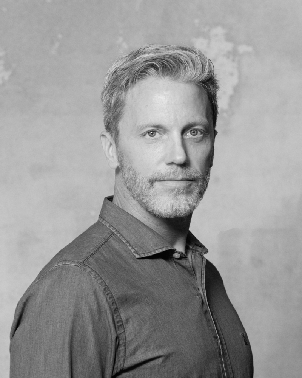
Doug Delaney




